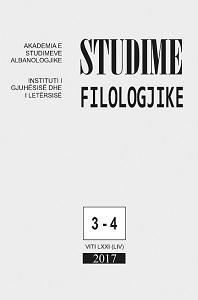Letërkëmbim dhe letërsi pasioni
Love Letters and Passion Literature
Author(s): Dritëro AgolliSubject(s): Studies of Literature, Albanian Literature, Sociology of Literature
Published by: Qendra e Studimeve Albanologjike
Keywords: Dritëro Agolli; Albanian literature; letters; passion;
Summary/Abstract: The epistolary character is present in the literature of D. Agolli in both forms: as a literary sub-genre and as private correspondence. In the novel The Devil’s Ark in the form of a letter to a friend, there is the novel The Forbidden Joke and 15 letters stored in the treasure chest for Hyskë Borobojka to read after his death. The letters exchanged between Dritëro Agolli and Gaqo Veshi in the years 1968-1969, signed with the heteronyms Bamkë Çomaga and Hyskë Borobojka, were published under the title Three persons laugh, one is enraged. Writing in the form of personal correspondence was an attempt to create another, an alter ego in his creativity, more redemptive, more justified for freedom of thought and expression. Dritero Agolli’s love letters date back to 1964-1965. There are altogether 64 letters stored in the family archives. This collection is of great importance not only for recognizing the writer’s internal world, but also for the fact that the tradition of intimate correspondence in Albania is very poor. There are many factors relating to the limitations of this form of writing, ranging from illiteracy to state control over correspondence both during the royal and the totalitarian period. The lack of intimacy in Albanian letters is an issue that requires deep anthropological research. D. Agolli’s correspondence, like any other correspondence, is addressed to a single reader, a girlfriend. But it can not exclude another reader, a projected one, a future reader, a public reader. The fact that the writer himself had arranged it in a booklet, leaving it ready for what he would like to publish, makes us think that this correspondence, since the time it was written, had two communications registers: first as love letters and second as passion literature. It is very easy to distinguish, within the same collection of letters, Dritëro Agolli as a writer, as a journalist, as orthos logos, from the other one: Dritëro Agolli as a narrator and writer. This correspondence can be considered as a source of resourceful information and data about what could be called home ethnography. Through that, the scholar can learn about the way of living in a traditional northern Muslim family and in a liberal Bektashi southern family; about the differences in rites and customs, about the cultural and regional differences. The publication of this correspondence serves the scholars to draw comparisons between D. Agolli’s non-literary works and his literature. These two genres often agree and often disagree. On the one hand, in the correspondence, there are characters that are seen in the light of the virtue and under the shadow of the vice; on the other hand, in literature, there are mostly enthusiastic characters, under the optics of revolutionary optimism and on the background of industrialization and emancipation. In his letters, D. Agolli is subject to tradition to prepare the wedding as Kanun demands, while in literature he quarrels with Lek Dukagjini and boasts of his conquest.
Journal: Studime Filologjike
- Issue Year: 2017
- Issue No: 03-04
- Page Range: 13-38
- Page Count: 26
- Language: Albanian

